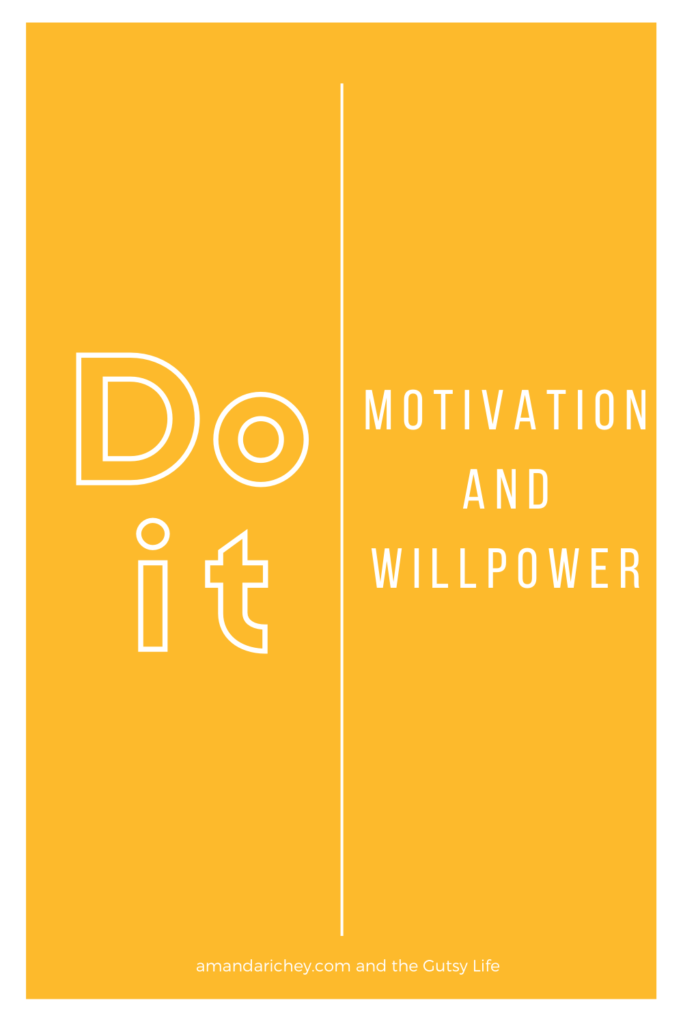Understanding your brain so you can push through to the Gutsy Life

Have you ever wondered if there is a way to improve or increase willpower, self control and motivation? In this post I cover the science behind your brain so you can understand willpower and motivation and maximize both.
The key to understanding willpower and motivation lies in understanding how the two are interacting in your brain on a mostly subconscious level. Once you understand how your brain works you can begin to identify how to change your subconscious responses and improve your willpower and motivation.
Motivation
Your brain is wired for survival, blame it on 200,000 years plus of evolution. Your brain wants to keep you alive and you are thus wired to avoid things that are uncomfortable or scary or difficult. Because of this, when faced with something scary different or uncertain you will hesitate. That hesitation, even just a microsecond, will send a fear signal to your brain and your brain will start firing looking for the threat and trying to remove you from it at all costs.
How it works
We have a conscious mind and a subconscious mind. Our conscious mind is controlled by the prefrontal cortex, a section of your brain located right behind your forehead. This region is responsible for decision making, self-control, willpower, and regulating behavior and does not fully develop until after puberty. Our subconscious mind however, is fully developed at birth, and is controlled by the basal ganglia which is responsible for emotions, habits, behavior, basic instincts, in essence ‘habit loops’ or ingrained behaviors you preform unconsciously.
The subconscious mind is in charge, even when we think our conscious mind is running things.
The fear response starts in the subconscious mind, in a region of the brain called the amygdala, closely related to the basal ganglia. When in fear, a threat stimulus triggers a fear response in the amygdala, which activates areas responsible for motor functions such as ‘fight or flight’ responses as well as releasing stress hormones. This results in the body responding to danger by becoming hyperalert.
The analytical or conscious response to fear occurs in the prefrontal cortex which helps the brain interpret the perceived threat. That perception of whether a threat is real depends on whether we feel we are in control.
What this means for you and your motivation is that you are never going to feel like doing something uncomfortable, or scary or hard, and waiting for that to change is a lost cause because, did I mention you have 200,000 years of evolution working against you? Don’t fight that. Just realize that you are never going to feel like or have the motivation to take the necessary steps to follow or accomplish what you want in life. You are going to have to change the way you think by moving through the hesitation and taking action.
How to fix this
Now that you understand how your brain works you can begin to identify how to change your subconscious responses and improve your willpower and motivation by pushing through yuour fear.
To push through this fear you must engage your prefrontal cortex. The best way to do this is with the 5 Second Rule (Mel Robbins). The Five Second Rule is simple: by counting backwards from five you engage your prefrontal cortex (remember that one? Responsible for self-control?) and interrupt the basal ganglia (responsible for emotions, habits, behavior, basic instincts etc) and stop or interrupt the ‘habit loops’ in your brain.
By counting backwards from five, you hit one and it acts as a prompt to move (if you counted up you could just keep counting!) That prompt acts as a starting ritual which researchers have found to be a proven method of new habit formation. By doing this you can interrupt old subconscious habits and will engage your prefrontal cortex to help you to create new habits such as acting through fear, hesitation, and uncertainty.
We all know what we need to do: stick to a diet, quit smoking, change our lives, we have a wealth of knowledge at our fingertips with the internet and google, so why can’t we just do it already?
Because you are in your head. Stop thinking about what you need to do and start doing it. Remember your brain is hardwired for survival and to avoid scary, uncertain, difficult situations. You have to learn to move from thinking about doing something to acting.
Check out this great video where she explains all of this in greater detail https://melrobbins.com/blog/never-going-to-feel/) and you can also read bestselling book of the same name.
“It (the 5 Second Rule) will become a habit that prompts you to have confidence and courage, but in the beginning it interrupts patterns of behavior that you do on autopilot, it helps you assert control and it teaches you how to become the kind of person that moves from thinking about something to actually doing it.”
Mel Robins

Willpower
Willpower is controlled by the prefrontal cortex. The prefrontal cortex, if you remember, is the conscious or analytical part of the brain. This is bad news because the subconscious part of our brain is what is usually running the show. This means that willpower is not automatic, and chances are, your subconscious has some pretty good ‘habit loops’ made to keep you from using your will power to do things it perceives as a threat (remember anything new or different).
But there are ways to help it! To aid your prefrontal cortex you must give it fuel: sleep, good food, exercise, and a break from decision making.
How it works
Willpower, you see, is not finite. It gradually depletes with every decision you are forced to make. This concept is called decision fatigue, and it is a term coined by Roy F. Baumeister, a social psychologist, that describes the finite store of mental energy one has in exerting self-control. Once you are mentally depleted you are less likely to consider a trade-off or compromise, you might just pick the easiest, best, or cheapest option for example.
You can see how decision fatigue can result in an inability to stick to, or implement new habits, take steps to working on a goal, improving your health, doing what you know would be better for you, etc. If you have a busy day, or just a life that requires you to work and manage your thoughts, by the time you try to tackle the things that are important to you, you may be so mentally depleted that you chose and easier option:
“ill just do it tomorrow…”
When this happens, your brain has slipped back in to its comfortable, predictable way of doing things, meaning your subconscious and your habit loops are running the show. Now that you understand how your brain works you can improve your willpower and motivation. Here is how:
How to fix this
1.Eliminate decision fatigue by planning the day before it begins. This could mean having your time all blocked out, your appointments and to do lists read the night before, this could also mean having your lunch packed the night before, having your dinners already set for the week, even having your clothes laid out the night before.
Side note: Steve Jobs famously wore the same thing every day; black turtleneck and jeans, to eliminate one more decision each day so he had more brain energy to focus on the important decisions.
2. Make a plan B. Use an “if ___ then ___” statement. For example: If I don’t make it to the gym, then I will go for a walk instead. If I don’t make a lunch in the morning then I will get a sandwich at the deli instead of the vending machine. Etc.
3. Be greedy with your time: Do the things that are most important to you first. If that is health and exercise, meditation, working on your business, your goals, your gratitudes, do it first. When your tank of willpower is the most full. If this is not possible plan your day to avoid obstacles specifically at the end of the day when willpower is lowest.
For example if you need to go to the gym after work, bring the clothes with you in the morning and don’t go home first. If resisting eating out at night is hard prep a meal before you leave in the morning, etc. Or, just get up earlier! I try to get up at 5:00 am to get my exercise and mediation time in because I know that the likelihood of me doing it after baby goes to bed is VERY VERY low!
The reality is, somedays your willpower is like an Iphone battery, where you can’t ever seem to keep it charged, and other days, days when you have probably had good sleep and exercise, you are able to handle difficult situations with grace and ease and stick with the plans you have set for your day and your time.
The more decisions you have to make in a day, specifically the ones that require self-control, the more decision fatigue you will experience and by the end of the day your willpower will be next to gone! Understanding this and planning accordingly can alleviate decision fatigue and help you to stay the course and achieve the things you want in life, be that sticking with a diet, establishing a morning routine, making $100k. You can have more willpower! Just understand how and when!

To sum up
Your brain wants to keep you alive. This means it wants to do the easiest thing and to avoid new, scary, or different things. Your brain will keep you in your comfortable ‘habit loops’ and will sound the alarm when you try to make it do something new.
This is not a dire as it sounds because you do have control!
Now that you know and understand that it is possible to improve or increase willpower, self control and motivation you can go out and do it! Because you know what is going on in your brain you can start to rewire those ‘habit loops’. Use the 5 Second Rule to push through the hesitation and create a new ‘habit loop’. Plan your day to eliminate obstacles and increase willpower. Don’t beat yourself up, it will take time, you are working through years of ingrained thoughts and millennia of brain evolution
Now, go crush your goals!



Get information actually great formation on how her brain works and now I know what to do to control it so I think Haha!
I am so glad it was useful to you. Learning about how the brain works was such a relief for me because it took the pressure off. If we all have brains that are just trying to keep us alive then we are all struggling to do the hard things, and all we need to do is re-train our brains!
Self-motivation is like a fire that burns within us, pushing us to overcome obstacles and reach new heights. This blog perfectly encapsulates the significance of self-motivation and offers practical advice on how to foster and maintain it. I particularly resonated with the notion that self-motivation is a habit that can be developed through consistent action and positive reinforcement. The tips shared, such as visualizing success and surrounding oneself with supportive people, are truly empowering. Let’s harness our inner motivation, stay focused on our dreams, and inspire others to do the same. We all have the power to create our own success stories
Motivation is not a fleeting feeling; it’s a mindset, a driving force that propels us forward even when faced with obstacles. It’s about finding that inner spark, that burning desire to pursue our dreams and never settle for mediocrity.
I am so glad it was useful to you. Learning about how the brain works was such a relief for me because it took the pressure off. If we all have brains that are just trying to keep us alive then we are all struggling to do the hard things, and all we need to do is re-train our brains! Your Keyword
I am currently writing a paper that is very related to your content. I read your article and I have some questions. I would like to ask you. Can you answer me? I’ll keep an eye out for your reply. 20bet
I would be happy to answer any questions you have! The contact me form would be the easiest way to discuss!
We all need motivation to come out of our comfort zone.
Soulful recently posted…Healing anxiety and overthinking
We do, that is for sure!
Will power is more important than motivation.
Exactly! Motivation is a myth. You have to train yourself to do the thing before you feel like it (motivation)
Motivation and willpower 👍 awesome topic…. Really interesting and useful.
I am so glad you found it useful!
motivation is the spark that gets us started, while willpower is the strength that keeps us going, even when challenges arise.